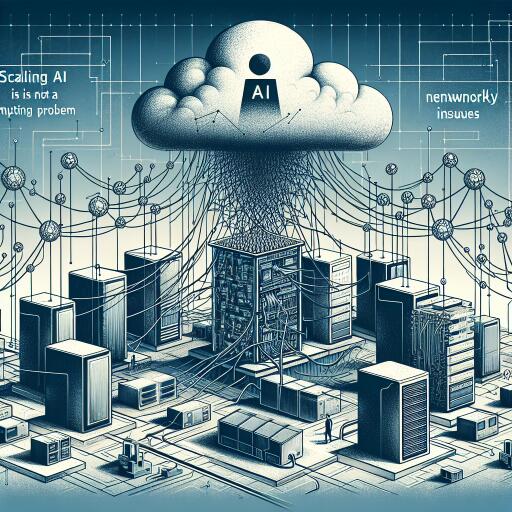Scaling AI Challenges: Why Networks Hold the Key
As artificial intelligence (AI) continues to evolve, its dependence on computational power grows exponentially. AI models are becoming ever more sophisticated, requiring an advanced level of computing for both training and inference stages. The pursuit of expanding computing capabilities has led teams to innovate in hardware architectures and distributed computing techniques. Yet, the journey to scale AI effectively goes beyond just amplifying computational power—it’s intricately linked to the capabilities of network infrastructures.
Reflecting on the 1960s, a prediction by an Intel cofounder, known as “Moore’s Law,” anticipated the doubling of transistors on a microchip approximately every two years—a trend that has remarkably shaped the evolution of computing devices. Despite the ongoing discourse around the physical constraints of silicon-based semiconductors, Moore’s Law persists. However, AI’s computational needs, doubling every six months, surpass the expansion rate of chip capacity, directing attention towards distributed computing as a solution to meet the surging demand.
Today, AI’s growth revitalizes interest in massively parallel infrastructures, with GPUs (graphics processing units) and TPUs (tensor processing units) becoming integral for AI model training. Developments in distributed computing infrastructures aim to enhance the connectivity among computing nodes, addressing the escalating complexity and demand for scalable computing resources.
Yet, the computational aspect is only one side of the AI scalability coin. The underlying network architecture and infrastructure play a crucial role in the efficient and effective performance of AI systems. The advancement of AI increasingly reveals the network as the primary bottleneck when distributing data and workloads across multiple nodes. High-speed interconnects and optimized communication protocols are among the networking innovations that promise to uphold the scale and speed required by contemporary AI applications.
Several ways in which networking influences the scalability of AI include:
- Dataset Distribution: The need for AI systems to access vast quantities of data from diverse sources necessitates efficient data distribution and access solutions, such as distributed storage systems and data caching.
- Model Training: Training extensive AI models typically involves parallel processing across several computing nodes, where maintaining efficient inter-node communication is vital to mitigate network latency or bandwidth issues.
- Model Distribution and Inference: Deploying AI models across distributed environments, like edge devices or cloud servers, requires effective distribution strategies supported by low-latency networks to facilitate real-time inference for applications such as autonomous vehicles and industrial automation.
Network operations teams, already familiar with managing bandwidth for latency-sensitive applications, face new challenges with the expansion of AI models and applications. These challenges range from the complexity of overseeing multivendor networks to the alarm noise generated by an increasing number of network components, underscoring the need for advanced tools and methodologies in network management.
Interestingly, forecasts by Gartner analysts predict that by 2027, 90% of enterprises will incorporate AI functionalities to refine network operations. AI-enhanced network management can simplify workflows and offer analytics, aiding NOC teams in navigating the complexity of modern, multivendor network environments. With a growing demand for AI applications, augmenting NOC teams with AI capabilities becomes crucial for ensuring robust and reliable network operations.
To truly harness the potential of AI in managing modern networks, solutions must be specifically designed for the networking domain, combining diverse intelligence areas such as fault management, topology, configuration, performance, and network experience. Such AI-enhanced solutions can provide the insights necessary for delivering high-performance connectivity across digital infrastructures.
In essence, the challenge of scaling AI transcends the realm of computing to encapsulate a network problem. For AI deployments to be effective, they necessitate robust networks that can manage the extensive data traffic generated by model training and accommodate the latency demands of real-time applications. Given the limitations of traditional network management tools in addressing the complexities AI introduces, new approaches and solutions are essential.
AI-powered network observability solutions stand out as pivotal for addressing AI’s challenges, streamlining workflows, and enhancing operational efficiency. To successfully embrace AI, NOC teams require solutions adeptly tailored to the distinct requirements of networking technologies, fostering an environment that can meet the burgeoning demands of AI applications and catalyze innovation in the digital age.
Forbes Technology Council is an invitation-only community for world-class CIOs, CTOs, and technology executives.










